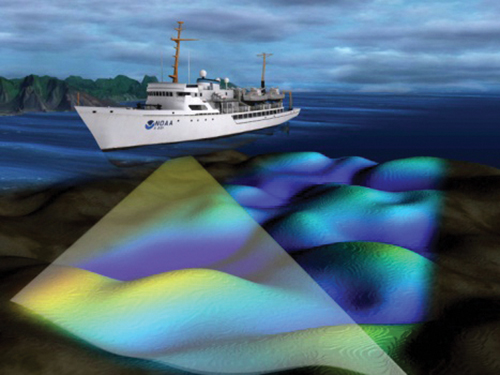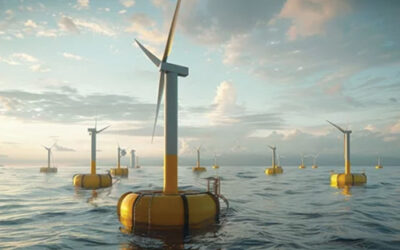Rendering illustrates how underwater sound testing is done from a ship with different types of testing equipment. Photo courtesy BOEM
The first of three companies trying to build offshore floating wind farms off the Central Coast is beginning extensive surveying and study of the wind farm site and the path transmission cables will take to bring the energy to shore.
According to an email notice sent to commercial fishermen and shared with Estero Bay News, Atlas Wind, a division of leaseholder Equinor, planned to start “conducting geophysical and geotechnical surveys” on April 1 and were expected to continue through the end of the year.
“Offshore surveys will take place on a 24-hour-per-day basis,” the company reported, “and near-shore surveys will take place on a 12-hour-per-day (day light only) basis.”
The plan is to conduct surveys of the seafloor in the “Morro Bay Call Area” as the nearly 400 square mile lease area is referred, and along the roughly 60-mile corridor where the transmission cables will run to Morro Bay. The power is expected to come ashore at the Morro Bay Power Plant and connect to the State’s power grid. The transmission corridor for testing will be some 2,000-meters (6,562 feet or about 1.3 miles) wide.
They plan to use underwater vehicles to do the testing using powerful sound waves.
“High resolution geophysical surveys [HRG],” the email said, “will be completed using autonomous underwater vehicles [AUVs] and with equipment towed behind a surface vessel.”
According to the Bureau of Ocean Energy Management or BOEM, which is the Federal agency overseeing the project, “HRG surveys are focused on the seafloor or shallow subsurface and use a high frequency acoustic source. The energy source is typically electromechanical, but a small air gun (20-90 cubic inches) may be used on occasion.”
There are three types of sound mapping or “sonar” commonly used — so-called Boomer, Chirp and Sparker — each employing different undersea vehicles towed behind ships. The technology employed has changed over time.
“Today,” BOEM’s paper reads, “HRG surveys often combine tools, such as multi-beam echo sounder, side-scan sonar and sub bottom profiler into one subsurface package; an Autonomous Underwater Vehicle or AUV. The AUV is operated approximately 150-feet above the seafloor.”
In the call area, that device will be sent down over half a mile, as the water depth in the call area, 20-30 miles off the Coast of San Simeon, is from 800-1,300 meters deep (2,600 to 4,225-feet deep).
They will also sample the sea bottom and the living things it contains. “Geotechnical and benthic sampling surveys,” Equinor’s email said, “will occur within the Lease Area and along the submarine export cable siting corridors in federal and state waters.”
Here too they will employ different devices to include “cone penetration testing equipment (CPT), vibracorer, piston corer, Young-modified Van Veen Grab, and Sediment Profile and Plan View Imager.” Each of these employs a different way to do the same basic thing — uncovering the makeup of the seafloor sediments.
With different types of equipment and depths involved, Atlas Wind plans to use different devices and ships, none of which will be small enough to enter Morro Bay Harbor.
“For survey operations at depths greater than approximately 328 feet [100 meters],” Equinor said, “Motor Vessel [M/V] Island Pride, a 338 ft. [103m] long multi-purpose subsea vessel, will be used.”
And, “For survey operations in shallower near-shore areas, the Research Vessel [R/V] Taku, a 30 ft. [9.1m] long near-shore survey vessel, or similar small research vessel will be used.”
The M/V Island Pride, “will not use the port facilities at Morro Bay Harbor or Port San Luis.”
The message to commercial fishing boats was clear. “Approaching vessels are requested to pass at a safe speed and distance.”
These sound tests have been a major concern for a local citizens’ group that has formed with the goal of educating the public about the projects and stands opposed to the wind farms because of the environmental impacts. Those may begin to be defined, as the high energy sound testing gets underway. High energy sound waves are feared to be a danger to marine mammals — whales and dolphins — that use hearing for finding food, navigation and communication. High energy sound blasts like with these tests, is feared to cause hearing damage and is suspected of causing dozens of wright whales and dolphins to strand themselves off the East Coast. Thus far, the wind energy companies doing those surveys, have denied being the cause and the government has not identified the cause of the whale deaths.
The REACT Alliance (see: www.reactalliance.org/offshore-wind) stands opposed to what it terms the industrialization of the ocean.
“Most folks have no idea of the scope of the wind farm facilities [1,000-feet tall and needing a square mile each],” REACT Alliance said on its website, “the planned industrialization of our small local ports, the potentially ruinous outcome for our current thriving local economies, the devastation of our local fisheries, and finally the extreme negative impacts to our local marine ecosystem, one of the richest and most biologically productive on earth.”
The issue has two unlikely allies — environmentalists and commercial fishers — coming together in a common cause to stop the wind farms.
But that is also not the only somewhat odd couple in this saga. Commercial fishermen are also cooperating with the State and the wind companies, according to Equinor.
“Equinor is a member of the California Coastal Commission 7c Offshore Wind and Fisheries Working group,” the company’s email reads.
Equinor Wind, LLC is one of three companies that won the roughly 80,000-acre lease sites sold off by BOEM last July. The others were Golden State Wind, Inc., and Invenergy California Offshore, Inc.
Equinor’s lease area is the most northerly of the three, with GSW and Invenergy located in the middle and to the south respectively.
Equinor paid $130 million, GSW paid $150 million and Invenergy $145 million for the rights to try and build the wind farms. The initial capacity identified by BOEM was 3 gigawatts (3,000 megawatts) total, but the wind companies apparently don’t plan to stop there. Atlas Wind’s website alone identified its lease site as having capacity for 2 GW.




